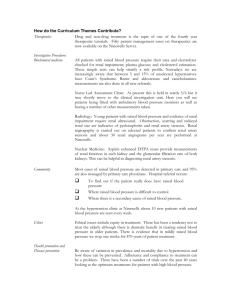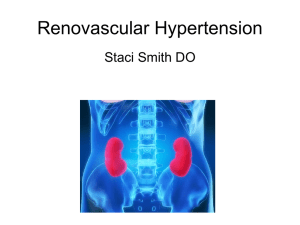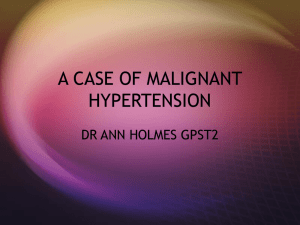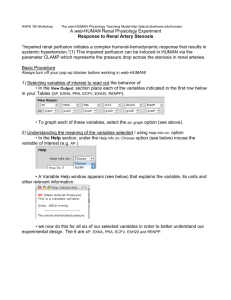Document 14233337
advertisement
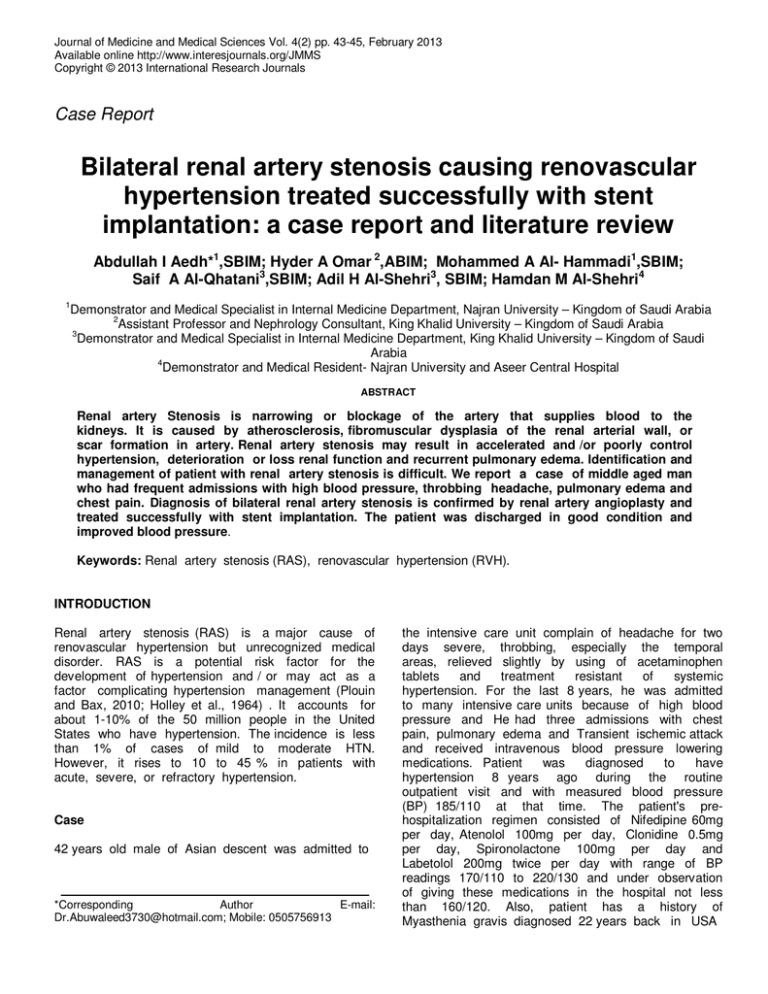
Journal of Medicine and Medical Sciences Vol. 4(2) pp. 43-45, February 2013 Available online http://www.interesjournals.org/JMMS Copyright © 2013 International Research Journals Case Report Bilateral renal artery stenosis causing renovascular hypertension treated successfully with stent implantation: a case report and literature review Abdullah I Aedh*1,SBIM; Hyder A Omar 2,ABIM; Mohammed A Al- Hammadi1,SBIM; Saif A Al-Qhatani3,SBIM; Adil H Al-Shehri3, SBIM; Hamdan M Al-Shehri4 1 Demonstrator and Medical Specialist in Internal Medicine Department, Najran University – Kingdom of Saudi Arabia 2 Assistant Professor and Nephrology Consultant, King Khalid University – Kingdom of Saudi Arabia 3 Demonstrator and Medical Specialist in Internal Medicine Department, King Khalid University – Kingdom of Saudi Arabia 4 Demonstrator and Medical Resident- Najran University and Aseer Central Hospital ABSTRACT Renal artery Stenosis is narrowing or blockage of the artery that supplies blood to the kidneys. It is caused by atherosclerosis, fibromuscular dysplasia of the renal arterial wall, or scar formation in artery. Renal artery stenosis may result in accelerated and /or poorly control hypertension, deterioration or loss renal function and recurrent pulmonary edema. Identification and management of patient with renal artery stenosis is difficult. We report a case of middle aged man who had frequent admissions with high blood pressure, throbbing headache, pulmonary edema and chest pain. Diagnosis of bilateral renal artery stenosis is confirmed by renal artery angioplasty and treated successfully with stent implantation. The patient was discharged in good condition and improved blood pressure. Keywords: Renal artery stenosis (RAS), renovascular hypertension (RVH). INTRODUCTION Renal artery stenosis (RAS) is a major cause of renovascular hypertension but unrecognized medical disorder. RAS is a potential risk factor for the development of hypertension and / or may act as a factor complicating hypertension management (Plouin and Bax, 2010; Holley et al., 1964) . It accounts for about 1-10% of the 50 million people in the United States who have hypertension. The incidence is less than 1% of cases of mild to moderate HTN. However, it rises to 10 to 45 % in patients with acute, severe, or refractory hypertension. Case 42 years old male of Asian descent was admitted to *Corresponding Author E-mail: Dr.Abuwaleed3730@hotmail.com; Mobile: 0505756913 the intensive care unit complain of headache for two days severe, throbbing, especially the temporal areas, relieved slightly by using of acetaminophen tablets and treatment resistant of systemic hypertension. For the last 8 years, he was admitted to many intensive care units because of high blood pressure and He had three admissions with chest pain, pulmonary edema and Transient ischemic attack and received intravenous blood pressure lowering medications. Patient was diagnosed to have hypertension 8 years ago during the routine outpatient visit and with measured blood pressure (BP) 185/110 at that time. The patient's prehospitalization regimen consisted of Nifedipine 60mg per day, Atenolol 100mg per day, Clonidine 0.5mg per day, Spironolactone 100mg per day and Labetolol 200mg twice per day with range of BP readings 170/110 to 220/130 and under observation of giving these medications in the hospital not less than 160/120. Also, patient has a history of Myasthenia gravis diagnosed 22 years back in USA 44 J. Med. Med. Sci. treated medically. He is known to have chronic kidney disease secondary to glomerulonephritis which is confirmed by biopsy. Since 1994 and was treated with steroid in the past with full recovery of proteinurea. The patient denied history of smoking, alcohol intake or use of any psycho-stimulating (including caffeine containing products) remedies. At Emergency room, the patient is conscious, oriented with weight of 76 kilogram and body mass index of 26kg/m2. BP was 210/94 mm Hg in the right arm and 210/98 mm Hg in the left arm, without orthostatic change. The heart rate was 70 beats per minute, and the respiratory rate was 16 breaths per minute. Findings on the ophthalmologic and funduscopic examinations were stage III hypertensive retinopathy. The lungs were clear to auscultation. Cardiac examination detected a displaced apex beat in the 6th left intercostal space with regular rhythm and normal first and second heart sounds with fourth heart sound without murmurs. No bruit was audible on abdominal examination. Pedal pulses were present in the extremities. There was no peripheral edema. His initial investigations revealed complete blood count, electrolytes, liver function tests, troponin level, fasting lipid panel, fasting glucose (on 2 separate occasions) and thyroid function tests were all within normal limits. Urea of 39mg/dl, Creatinine of 1.3mg/dl and calculated GFR of 79ml/min/1.73m2. Electrocardiogram (ECG) demonstrated sinus rhythm, and left ventricular hypertrophy (LVH). A recent echocardiogram revealed moderate LVH and normal left ventricular contractility. A recent chest radiograph was unremarkable. Serum catacholamines and 24 hour urine metanepherines were within normal range. Renin activity and serum aldosterone within normal range. Computed tomography of the Abdomen showed there was no adrenal masses nor renal pathology seen . The patient underwent two renal angiogram in two different hospitals and reported to be normal and the third in our hospital to show 80% stenosis of the left renal artery and 90% stenosis of the right renal artery. During the same procedure, the patient underwent successful stenting bilaterally of the renal arteries, with complete normalization of the arterial lumens. Three weeks after renal arteries stenting, the patient clinically improved in form of decreasing blood pressure and less medications. Last outpatient clinic visit, the patient blood pressure was 130/80 on Nifedipine 20mg per oral twice daily. DISCUSSION Renal artery stenosis is becoming increasing in incidence and found to be the commonest cause of chronic kidney disease and end stage renal disease in the elderly (Plouin and Bax, 2010). Renal artery stenosis incidence rate in 2 studies of patients with severe hypertension was 27-45% in white persons compared to 8-19% in African American persons. These patients may present with symptoms of renal insufficiency or uncontrolled hypertension. Renal artery stenosis is often missed as an important cause of secondary hypertension and often correctable cause. The result of this stenosis in the renal arteries is a systemic hypertension (Mehta and Fenves, 2010). The patient need to be screened for renal artery stenosis should have all these criteria which are (Textor and Lerman, 2010): The clinical findings suggest secondary hypertension, The patient does not appear to have another cause of secondary hypertension such as primary kidney disease, primary aldosteronism, or pheochromocytom. Intervention will be done if there is significant stenosis. The mechanism of how RAS leads to hypertension is related to the hypersecretion of renin by the ischemic kidney. The excess renin accelerates the conversion of angiotensin I to angiotensin II and that promotes the release of aldosterone by the adrenal gland resulting in vasoconstriction and fluid retention leading to true and medically resistant hypertension (Mehta and Fenves, 2010). Roughly 90% of RAS patients, the etiology of renal artery stenosis is atherosclerosis, primarily in older persons and is those with diffuse atherosclerotic disease. The majority of the remaining 10%, the etiology is fibromuscular dysplasia which primarily affects younger persons without evidence of other vascular disease (Safian and Textor, 2001). RAS should be suspected in cases of resistant hypertension which is defined as inability to reach target BP using at least three different antihypertensive medications including diuretic (Pisoni et al., 2009). Some patients with RAS may present with opthalmic manifestations of hypertension, cardiomegaly, abdominal bruit or renal insufficiency. Our patient present with hypertensive retinopathy and renal insufficiency. Our patient could have primary hypertension exacerbated by RAS or RAS causing hypertension which is most likely the case as he had severe hypertension from the beginning not controlled by multiple medications, not like those who were controlled on one or two medications then became resistant. Duplex ultrasound imaging of the renal arteries is useful for detection of increased Doppler velocities bilaterally, consistent with significant RAS. This is relatively inexpensive and noninvasive and does not require the use of a contrast agent and is highly sensitive and specific, but has the disadvantages that it is somewhat time-intensive and depends upon the experience of the technologist (Olin et al., 1995). Spiral Aedh et al. 45 CT angiography can also be used which has more accurate visualization of the renal arteries but iodinated contrast should be used (Mehta and Fenves, 2010). Magnetic resonance angiography (MRA) is a noninvasive imaging modality for the detection and evaluation of RAS especially that is located in the proximal portion of the renal arteries but has gadolinium should be used which may be rarely associated with the development of nephrogenic systemic fibrosis in patients with moderate or severe renal impairment (Plouin and Bax, 2010). The gold standard for diagnosis and evaluation of RAS is renal arteriography which is invasive and requires intravenous contrast but has the advantages of more visualization of renal arteries and evaluating of extent of the stenosis. Other advantage is possibility of performing stenting (Mehta and Fenves, 2010). As other hypertensive patients, should reduce sodium and fat in their diet. Encourage them to avoid tobacco and increase physical activity. Consider more than one antihypertensive medication of different classes (Plouin and Bax, 2010). Renal angioplasty is generally safe and effective and the Blood Pressure is improving and becoming controlled in some studies (Balk et al., 2006). Some studies showed no benefit from angioplasty with stenting compared to medical therapy with respect to both blood pressure control and renal function (Astral et al., 2009; Bax et al., 2009; Van et al., 2000) and no difference in cardiovascular events and mortality (Astral et al., 2009; Bax et al., 2009). Until the early 1990’s, surgical renal artery revascularization was primarily performed for RAS. In 1993, secondary patency, reduction in blood pressure and improvement in renal function were found to be similar with surgery or Percutaneous transluminal renal angioplasty (PTRA). PTRA was associated with a decreased number of complications. Currently, surgical revascularization is rarely performed solely for RAS. Surgical revascularization or removal of a completely occluded atrophic kidney appears to have similar efficacy to renal stenting (Weibull et al., 1993; Aurell and Jensen, 1997). The case report highlights the difficulty of reaching a correct diagnosis and its’ importance. In addition, it highlights the multiple imagistic methods needed in order to accurately identify the respective etiology and reveals the usefulness of the interventional treatment for this rare pathology. Balloon angioplasty with stenting emphasizes favorable outcomes such as increasing life expectancy and improving the quality of life for these patients, as well as improving their long-term prognosis. REFERENCES Astral Investigators, Wheatley K, Ives N (2009). Revascularization versus medical therapy for renal-artery stenosis. N Engl J Med; 361:1953. Aurell M, Jensen G (1997). Treatment of renovascular hypertension. Nephron; 75:373. Balk E, Raman G, Chung M (2006). Effectiveness of management strategies for renal artery stenosis: a systematic review. Ann Intern Med; 145:901. Bax L, Woittiez AJ, Kouwenberg HJ (2009). Stent placement in patients with atherosclerotic renal artery stenosis and impaired renal function: a randomized trial. Ann Intern Med; 150:840. Holley KE, Hunt JC, Brown AL Jr (1964). Renal artery stenosis. A clinical-pathologic study in normotensive and hypertensive patients. Am J Med. Jul; 37:14-22. Mehta AN, Fenves A (2010). Current opinions in renovascular hypertension. Proc (Bayl Univ Med Cent). 23(3):246-249. Mehta AN, Fenves A (2010). Current opinions in renovascular hypertension. Proc (Bayl Univ Med Cent). 23(3):246-249. Mehta AN, Fenves A (2010). Current opinions in renovascular hypertension. Proc (Bayl Univ Med Cent). 23(3):246-249. Olin JW, Piedmonte MR, Young JR (1995). The utility of duplex ultrasound scanning of the renal arteries for diagnosing significant renal artery stenosis. Ann Intern Med. 122(11):833-838. Pisoni R, Ahmed MI, Calhoun DA (2009). Characterization and treatment of resistant hypertension. Curr Cardiol Rep 2009, 11:407– 413. Plouin PF, Bax L (2010). Diagnosis and treatment of renal artery stenosis. Nat Rev Nephrol. Mar:151-9. Safian RD, Textor SC (2001). Renal artery stenosis. N Engl J Med. 344(6):431-442. Textor SC, Lerman L (2010). Renovascular hypertension and ischemic nephropathy. Am J Hypertens 23:1159. Van Jaarsveld BC, Krijnen P, Pieterman H (2000). The effect of balloon angioplasty on hypertension in atherosclerotic renal-artery stenosis. Dutch Renal Artery Stenosis Intervention Cooperative Study Group. N Engl J Med; 342:1007. Weibull H, Bergqvist D, Bergentz SE (1993). Percutaneous transluminal renal angioplasty versus surgical reconstruction of atherosclerotic renal artery stenosis: A prospective randomized study. J Vasc Surg 18:841–850; discussion 850–852.)
